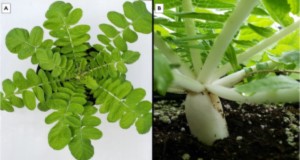Abstract
Daikon radish is a versatile vegetable crop in the mustard family. It produces a large, white, cylindrical fleshy root weighing up to 4-7 lb. Daikon radish is an especially common vegetable in Asia, particularly Japan, and it tends to be less spicy than other garden types of radish. This new 7-page publication of the UF/IFAS Horticultural Sciences Department provides a primer on cultivation of daikon in Florida, including sections on propagation, growing conditions, pests and diseases, and agricultural, culinary, and medicinal uses. Written by Mary Dixon and Guodong Liu.
https://edis.ifas.ufl.edu/hs1370
References
Borgman, M. 2018. "Radish variety can add flavor and crunch to your meals." Michigan State University Extension. Accessed May 18, 2020. https://www.canr.msu.edu/news/radish_variety_can_add_flavor_and_crunch_to_your_meals
Carlson, D. G., M. E. Daxenbichler, C. H. VanEtten, C. B. Hill, and P. H. Williams. 1985. "Glucosinolates in Radish Cultivars." Journal of the American Society for Horticultural Science 110 (5): 634.
Chu, C.-C., A. M. Simmons, T.-Y. Chen, P. J. Alexander, and T. J. Henneberry. 2008. "Lime Green Light Emitting Diode Equipped Yellow Sticky Card Traps for Monitoring Whiteflies, Aphids and Fungus Gnats in Greenhouses." Insect Science 11 (2): 125-133. https://doi.org/10.1111/j.1744-7917.2004.tb00186.x
Daly, H. V., J. T. Doyen, and A. H. Purcell III. 1998. "Ch. 14 Pest management." In Introduction to Insect Biology and Diversity. New York: Oxford University Press.
Dittmar, P. J., E. J. McAvoy, M. Ozores-Hampton, R. N. Raid, H. A. Smith, S. E. Webb, L. Zotarelli, S. Zhang, C. F. Miller, and Q. Wang. 2019. Chapter 15: Root Crop Production in Florida. In Vegetable Production Handbook of Florida, 2019-2020 edition. HS965. Gainesville: University of Florida Institute of Food and Agricultural Sciences. https://edis.ifas.ufl.edu/cv300
Guan, W. 2017. "Daikon Radish." Purdue University Extension Vegetable Crops Hotline.
Guo, Y. P., D. P. Guo, Y. Peng, and J. S. Chen. 2005. "Photosynthetic Responses of Radish (Raphanus saticus var. longipinnatus) Plants to Infection by Turnip Mosaic Virus." Photosynthetica 43 (3): 457-462. https://doi.org/10.1007/s11099-005-0073-3
Jones, D. R. 2003. "Plant Viruses Transmitted by Whiteflies." European Journal of Plant Pathology 109: 195-219. https://doi.org/10.1023/A:1022846630513
Kumar, S., S. Maji, S. Kumar, and H. D. Singh. 2014. "Efficacy of Organic Manures on Growth and Yield of Radish (Raphanus sativus L.) cv. Japanese White." International Journal of Plant Sciences (Muzaffarnagar) 9 (1): 57-60.
Larkcom, J., and E. Douglass. 1994. Oriental Vegetables: The Complete Guide for the Gardening Cook. New York: Oxford University Press US. pp. 114-115.
Levick, D. R., T. A. Evans, C. T. Stephens, and M. L. Lacy. 1985. "Etiology of Radish Scab and Its Control through Irrigation." The American Phytopathological Society 75 (5): 568-572. https://doi.org/10.1094/Phyto-75-568
Liu, G., E. H. Simonne, K. T. Morgan, G. J. Hochmuth, S. Agehara, and R. Mylavarapu. 2019. "Chapter 2. Fertilizer Management for Vegetable Production in Florida." In Vegetable Production Handbook of Florida 2019-2020 edition. HS296. Gainesville: University of Florida Institute of Food and Agricultural Sciences. https://edis.ifas.ufl.edu/cv296
Maynard, D. M., and G. J. Hochmuth. 2007. "Part 8 - Harvesting, Handling, and Storage." In Knott's Handbook for Vegetable Growers. 401-502. Hoboken, NJ: John Wiley and Sons.
Molinar, R. H., M. Yang, K. M. Klonsky, and R. L. De Moura. 2005. Sample Costs to Produce Daikon (Oriental Radish). DR-VS-05. University of California Cooperative Extension. Accessed May 18, 2020. https://coststudyfiles.ucdavis.edu/uploads/cs_public/d8/a3/d8a3d951-3251-4142-9fad-55e505e04c07/daikonvs2005.pdf
Multilingual Multiscript Plant Name Database. 1995. Raphanus sativus L. (Longipinnatus Group). Accessed May 18, 2020. http://www.plantnames.unimelb.edu.au/new/Raphanus.html#longipinnatus.
Murakami, H., S. Tsushima, T. Akimoto, K. Murakami, I. Goto, and Y. Shishido. 2001. "Effects of Growing Leafy Daikon (Raphanus sativus) on Populations of Plasmodiophora brassicae (Clubroot)." Plant Pathology 49: 584-589. https://doi.org/10.1046/j.1365-3059.2000.00495.x
Nakamura, Y., K. Nakamura, Y. Asai, T. Wada, K. Tanaka, T. Matsuo, S. Okamoto, J. Meijer, Y. Kitamura, A. Nishikawa, E. Y. Park, K. Sato, and K. Ohtsuki. 2008. "Comparison of the Gglucosinolate-Myrosinase Systems among Daikon (Raphanus sativus, Japanese White Radish) Varieties." Journal of Agricultural and Food Chemistry 56 (8): 2702-2707. https://doi.org/10.1021/jf7035774
Soltangheisi, A., M. Rodrigues, M. J. A. Coelho, A. M. Gasperini, L. R. Sartor, and P. S. Pavinato. 2018. "Changes in Soil Phosphorus Lability Promoted by Phosphate Sources and Cover Crops." Soil and Tillage Research 179: 20-28. https://doi.org/10.1016/j.still.2018.01.006
Stephens, J. M. 1994. Radish, Chinese-Raphanus sativus L. HS653. Gainesville: University of Florida Institute of Food and Agricultural Sciences. https://edis.ifas.ufl.edu/mv120
Thomas, R. B. 1987. The Old Farmer's Almanac. Dublin, NH: Yankee Publishing Incorporated.
Tsuji, S. 1980. Japanese Cooking: A Simple Art. Tokyo: Kodansha International.
USDA Food Data Central. 2019. "Radishes, Oriental, Raw." USDA Agricultural Research Service. Accessed May 18, 2020. https://fdc.nal.usda.gov/fdc-app.html#/food-details/168451/nutrients
Vig, A. P., G. Rampal, T. S. Thind, and S. Arora. 2009. "Bio-protective Effects of Glucosinolates: A Review." LWT - Food Science and Technology 42: 1561-1572. https://doi.org/10.1016/j.lwt.2009.05.023
Weil, R., C. White, and Y. Lawley. 2009. Forage Radish: New Multi-purpose Cover Crop for the Mid-Atlantic. Fact Sheet #824. College Park, MD: University of Maryland Extension.
Yasui, H., A. Kato, and M. Yazawa. 1998. "Antifeedants to Armyworms, Spodoptera litura and Pseudaletia separate, from Bitter Gourd Leaves, Momordica charantia." Journal of Chemical Ecology 24: 803-813. https://doi.org/10.1023/A:1022317432674
Unless otherwise specified, articles published in the EDIS journal after January 1, 2024 are licensed under a Creative Commons Attribution-NonCommercial-NoDerivs 4.0 International (CC BY-NC-ND 4.0) license.

